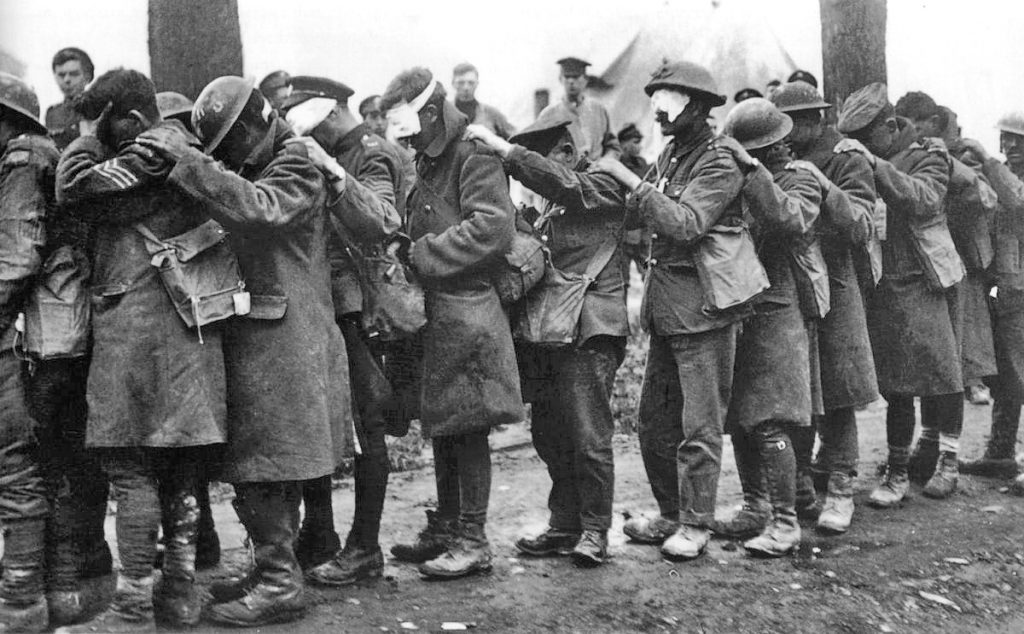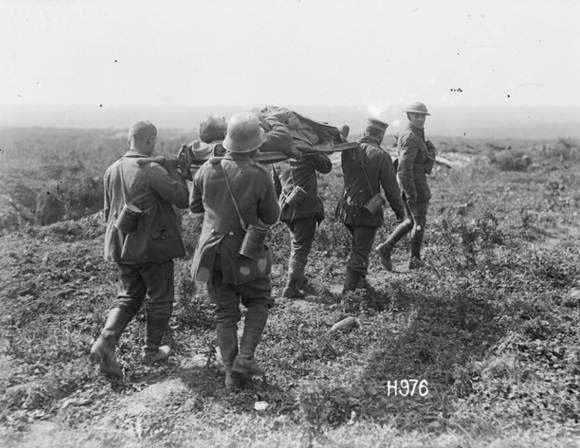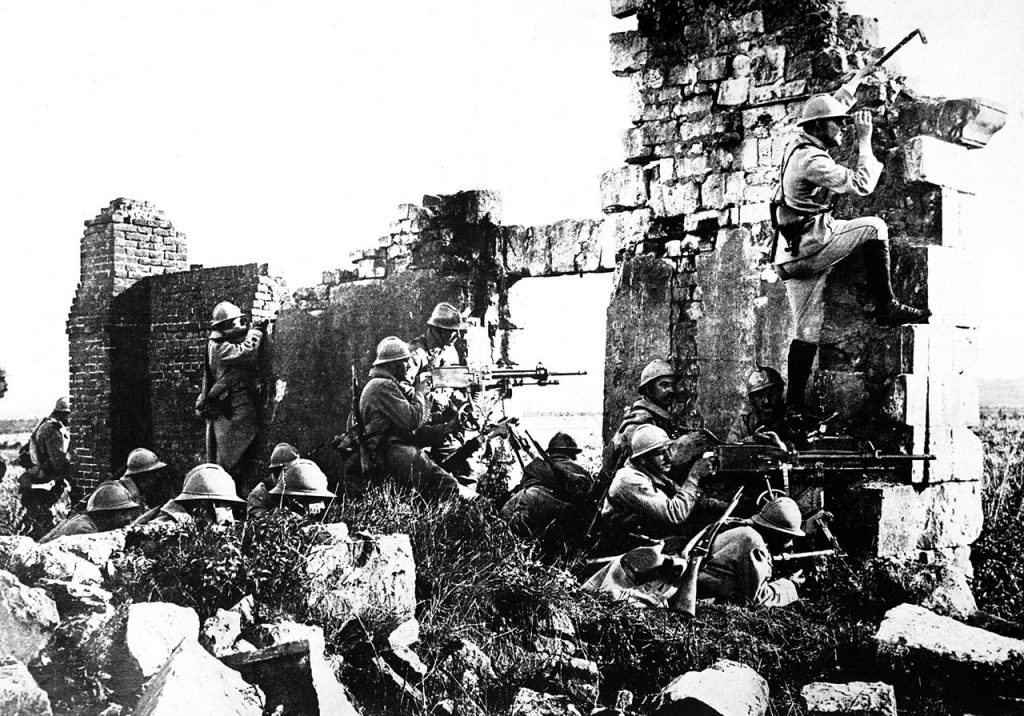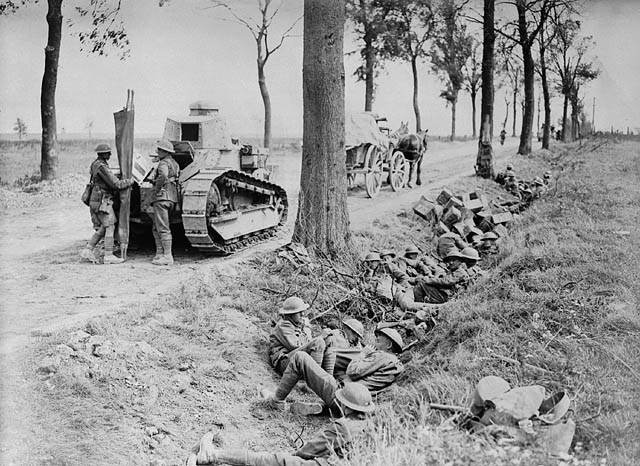
A hundred years ago today the world burned. On 8 August the Entente Powers of France and its colonies, the United Kingdom and its colonies, the United States, Canada, Australia, New Zealand, South Africa, British India, Belgium, Portugal and Italy launched a series of attacks which would become known as the Hundred Days Offensive. That offensive ended a century ago today at 11 AM Paris Time (noon in Germany).
In the spring of 1918 the Germans had launched a flurry of blows against the French and British lines in the West in an attempt to crack the Allied trench lines and defeat them before the masses of fresh Americans could arrive. The Germans failed. They found they could breakthrough in places but never move fast enough to prevent the French and British from reinforcing; all this for the price of 688,341 German and 864,374 Allied casualties. German troops before the attacks began in March outnumbered the Allies ~1.5 million to ~1.3 million. After mid-June the Germans would be increasingly outnumbered as more and more Americans arrived and the German 1918 conscription class would not be enough to even replace the losses incurred everyday.

The British launched the first attack on 8 August 1918 at Amiens. Twelve British, four Canadian, five Australian, and 12 French divisions supported by 1,386 field artillery and 684 heavy siege guns along with over 500 tanks were sent across the fields of Picardy against 14 German divisions. Over the next five days the Germans suffered a near total collapse in morale. General Erich Ludendorff, who along with Field Marshal Paul von Hindenburg ruled Germany as de facto military dictators, described 8 August as the “Black Day of the German Army.” German troops surrendered in huge numbers: 50,000 by 12 August. Men who were retreating would heckle and taunt soldiers marching towards the front with cries of “Blacklegs!” and “you’re prolonging the war!” The British Field Marshal Douglas Haig disagreed with Marshal of France and Supreme Commander of the Allied Armies Ferdinand Foch’s plan to continue the attack at the Somme. Haig refused to press on, preferring to launch new offensives elsewhere. On 21 August the British, Australians, Canadians and Americans launched an offensive at the Somme, where two years before nearly half a million British and Commonwealth troops became casualties in a bloody attempt to relieve the pressure on Verdun.

This time the Allied assault was able, in 13 days, to push the Germans back to the edge of the Hindenburg Line; the positions they had held before the Spring Offensive. Australian troops under General John Monash crossed the River Somme at Péronne and pushed three kilometers to Mont Saint-Quentin, a hundred meter high hill that was key to the German defenses in the area. On 29 September British, American, and Australian troops began the attack to seize the St. Quentin Canal. By 10 October the Allies had pierced the Hindenburg Line and the German Supreme Army Command realized there was no hope of victory.
Yet there would be 1.2 million more casualties before the war ended at 11:00 AM 11 November 1918. Sailors of the Kaiserliche Marine refused to die pointlessly in a suicide sortie against the Royal Navy. Their mutiny and declaration of a socialist republic forced the abdication of the Kaiser. Ludendorff, Hindenburg and the German military aristocracy was more concerned with preserving their own “honor” than saving the lives of their countrymen and insisted upon delaying talk of an armistice. And even when they acceded to the inevitable; the German generals cravenly refused to sign on the dotted line. They forced a newly formed civilian government to do it and after the war these same generals led the charge against the Weimar Republic; Ludendorff being the possible source of the term “stabbed-in-the-back.” He was also party to coup attempts against the German government. Marshal Foch at the Armistice at Compiègne refused to the German request that the ceasefire to be effective at the time of the signing (5 AM 11 November), but insisted that it only take effect at 11 AM. His demand can be explained by the fact the armistice was not a surrender; the war could have continued and the Allies felt they had to further strengthen their positions. That and revenge.

American Expeditionary Force General John J. Pershing ordered attacks on the morning of 11 November. His orders ensured that the last man to die in combat in the First World War was an American, Henry Nicholas Gunther, Private in the 313th Infantry Regiment, 79th Division. He was killed at 10:59, charging a German machine gun post in Lorraine. He had been recently demoted from Sergeant, after a letter he sent urging a friend back in the States to avoid conscription was picked up by Army censors. The man who replaced him as Sergeant, another friend, ordered the squad to stay put but Gunther stood up, fixed his bayonet and charged. The Germans, knowing the war was over in a minute, tried to wave him off. But he kept going and fired at the Germans who, not unreasonably had no desire to die themselves, killed Gunther in a burst of automatic fire. A British reporter interviewed his squad afterwards and they reported Gunther brooded over his demotion and became obsessed with redeeming himself in the eyes of his officers and comrades. You could call what Gunther did suicide by proxy, at least by dying in combat he guaranteed he wouldn’t be disgraced by the Army for his letter. He was 23 years old.
The victorious powers of France and Britain were fatally weakened by the effort. France lost 4.29-4.39% of its population. If the US were to lose 4.34% of its population today over the same period of time that would mean 14.25 million dead in four years. That translated into approximately one million more people than currently live in Pennsylvania, or the combined populations of Washington State and Arizona. Britain and its colonies (excluding the Dominions of Canada, Australia, New Zealand, South Africa, Newfoundland and the British Raj) lost 1.91-2.23% of its pre-War population. While Britain bled less, it lost its position as the preeminent power in the world. London would never again be the financial center of the world, New York City claimed that dubious prize. Other nations suffered far worse.

From the ashes of the Russian, Habsburg and Ottoman Empires rose new nations. Serbia achieved the dream of a unified South Slavic kingdom. Romania finally incorporated all Romanian speakers into their kingdom (and sizable Maygar, German, Ukrainian, Bulgarian, Jewish and Turkish minorities). Czechoslovakia was created and Poland restored to independence. The Arabs traded an Ottoman yoke for French and British ones under the guise of League of Nations Mandate. One could argue the nations of Canada, Australia and New Zealand were born in the War. Before 1914, the people living in Canada, Australia and New Zealand thought of themselves British subjects. After the war they began to think of themselves as nations separate and distinct from Great Britain. In 1923 the Canadian government asserted its right to independent diplomacy by stating that Canada would not automatically follow Britain into a conflict with Turkey.
There were other catastrophes and atrocities that wracked the world at the same time as the Great War that I have not discussed. In the Ottoman Empire, in what are now Turkey, Syria and Iraq, millions of Armenians, Assyrians and Greeks were killed in genocides. While famine killed hundreds of thousands more in Lebanon. The Spanish Flu, which despite the name started most likely either in China or Kansas but was so named because Spain did not have wartime censorship creating the illusion that Spain was the source, killed millions across the globe, possibly 3-5% of the global population at the time. In Russia, civil war raged while foreign troops meddled, famines followed. Mexico was still in the throes of revolution. A guerrilla war in Ireland would break out in 1919 and last until 1921. The War in many ways failed to end in 1918.

The amount of concentrated death is staggering. It is actually overwhelming and inconceivable to modern minds. Back in 2005 I remember the news media was obsessed with how the American military deaths in Iraq had finally reach 2,000 dead. During the Great War, we averaged that many deaths about every three days. The US today would not accept such casualties while fighting overseas. Our political and military leaders have learned how to minimize, obscure and hide the deaths in our current wars. While we have been able to avoid such high casualties, we have been inflicting them in the nations that we are fighting in. Half a million in Iraq, approximately 107,000 in Afghanistan, another half a million in Syria, and 100,000 in Yemen due to either direct (bullets, bombs, gas, etc.) or indirect (starvation, disease, exposure, etc.) causes of the wars in those countries. And in all of them the wars are still on going and with no end in sight. All of them are sustained by decisions and resources coming from Washington DC.
We are fighting wars that started in 2001 and the casus belli have shifted. The most politic answer we have today is to “maintain stability” or “national interest.” A more accurate answer should be inertia or pride, of which the former is monstrous, the latter pathetic. If stability is our goal we have failed spectacularly at that; we have the largest, most powerful military force in human history and are unable to decisively defeat a few thousand irregulars with Toyotas and small arms. If we stay the course in Afghanistan after 10 November 2019 it will be possible for an American to have been born after 11 September 2001, grow up, enlist, be sent to Afghanistan and be killed there. No other American war, excluding the cumulative of all Indian Wars, has that dubious distinction.

The War was fought in the fields of Flanders, the Ukrainian Steppe, the scrubland ridges of Gallipoli, the savannas of East Africa, the coasts of China and Chile, the jungles of New Guinea, the craggy peaks of the Dolomites, the sands of Palestine, the cold waters of the North Atlantic and the very site of Armageddon, in the Judean Hills near Tell Megiddo. But today a century ago the guns only went silent in Flanders. Elsewhere, they merely paused. In Russia civil war would rage until 1922. Greece and Turkey would fight a bloody war until the same year, culminating with pogroms and forcible population exchanges (and providing a dangerous example to other defeated nations of Germany and Hungary as the Allies had to accept a new treaty with Turkey). Revolution and counterrevolution swept the defeated Germany and Hungary. The erstwhile allies of Serbia and Italy immediately claimed territories in the collapsed Habsburg Empire. Romania would fight a war against Hungary for Transylvania. The War only ended for the French, the British and the Americans today a century ago.
We think we are beyond having to fight wars like we did in 1918. In some ways that’s entirely true; if there ever will be another general war between the Great Powers, it will be fought with nuclear weapons and hundreds of millions will die instead of “merely” tens of millions. And while the US has avoided mass casualty counts since Vietnam, we are inflicting them upon other nations. A century ago the world burned and humanity witnessed its first attempt at self inflicted Armageddon. Today the world still burns and we are never far from a more successful attempt.
